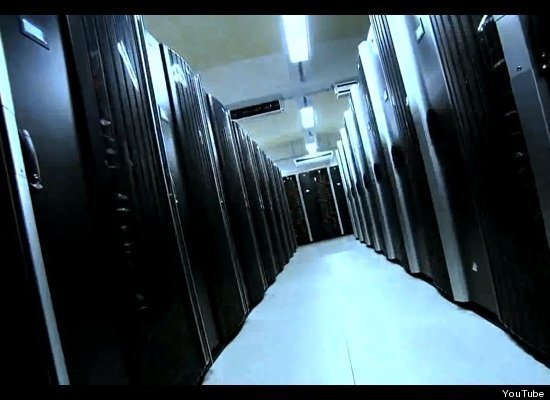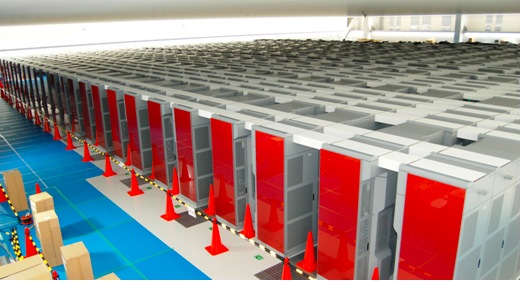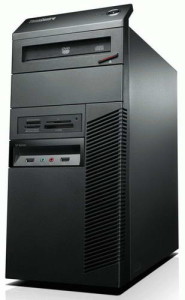Fujitsu K supercomputer now ranked fastest in the world, dethrones China’s Tianhe-1A and this supercomputer contains more than 80,000 CPUs with eight cores each. Fujitsu kept the 6D mesh torus interconnect that was created by the three vendors for the K machine and simply built the whole box using its four-socket, water-cooled blade servers instead of a mix of vector and scalar processors. Fujitsu created the eight-core Venus Sparc64-VIIIfx chip specifically for the machine………..
RIKEN and Fujitsu have taken first place on the 37th TOP500 list announced at the 26th International Supercomputing Conference (ISC’11) held in Hamburg, Germany. This ranking is based on a performance measurement of the “K computer,” currently under their joint development. The TOP500-ranked K computer system, currently in the configuration stage, has 672 computer racks equipped with a current total of 68,544 CPUs. This half-build system achieved the world’s best LINPACK benchmark performance of 8.162 petaflops (quadrillion floating-point operations per second) to place it at the head of the TOP500 list. In addition, the system has recorded high standards with a computing efficiency ratio of 93.0%. This is the first time since June 2004 that the Japanese supercomputer “Earth Simulator” has been ranked first on the TOP500 list. RIKEN and Fujitsu have been working together to develop the K computer with the aim of beginning shared use by November 2012, as a part of the High-Performance Computing Infrastructure (HPCI) initiative led by Japan’s Ministry of Education, Culture, Sports, Science and Technology (MEXT). The K computer will be comprised of over 800 computer racks-each equipped with ultrafast and energy-efficient CPUs-that access into a network capable of an immense amount of interconnectivity. The supercomputer system brings together leading-edge technologies for high performance and high reliability.
To test the system’s performance at the configuration stage, the K computer‘s processing speed was measured by the LINPACK benchmark program, placing it on the 37th TOP500 ranking of the world’s fastest supercomputers. The TOP500 ranking list began in 1993 and is updated twice a year in June and November. The LINPACK benchmark program, running on the part of the system that employs 68,544 CPUs installed on the K computer being configured, recorded the world’s top performance of 8.162 petaflops. This gave it the number-one position on the TOP500 list. Moreover, for one of the world’s largest supercomputers, it achieved an extraordinarily high computing efficiency ratio of 93.0%. This achievement is made possible by the K computer‘s integration of technologies, including its massive number of CPUs, the interconnectivity that links them together, and the software that is able to bring out the highest performance from the hardware. When configuration of the K computer is complete in 2012, it is designed to achieve LINPACK performance of 10 petaflops. It will be widely used in a variety of computational science fields where it is expected to contribute to the generation of world-class research results. The K computer is a wholly made-in-Japan supercomputer, from the research and development of the processors, to system design and manufacturing. Use of the K computer is expected to have a groundbreaking impact in fields ranging from global climate research, meteorology, disaster prevention, and medicine, thereby contributing to the creation of a prosperous and secure society. RIKEN and Fujitsu will continue to work tirelessly toward completing the system’s deployment in 2012.
Ryoji Noyori, President, RIKEN, said:
I would like to express my deep gratitude to everyone, beginning with our colleagues at our development partner Fujitsu Limited, who worked so valiantly on the construction of the K computer even under the severe conditions following the Great East Japan Earthquake. It is wonderful to be able to share the joy of this moment with them. I very much believe that the strength and perseverance that was demonstrated during this project will also make possible the recovery of the devastated Tohoku region. As we move forward to complete this project by next June, we will maintain our firm commitment to the maintenance and operation of the system, and I hope to see wonderful results when we begin to make the world’s top performing supercomputer available to users around the world.
Michiyoshi Mazuka, Chairman and Representative Director, Fujitsu Limited, said:
I am delighted that we were able to achieve this result, made possible through the tremendous efforts of all involved, despite the impact of the Great East Japan Earthquake. In particular, I am sincerely grateful to our partners in the Tohoku region for their commitment to delivering a steady supply of components, even though they themselves were affected by the disaster. Bringing together hundreds of thousands of components to quickly launch such a massive-scale computing system-which would have been nearly impossible using conventional technologies-requires an incredible level of reliability. I believe that this reliability is truly the pinnacle of Japanese manufacturing. Without being too pleased with ourselves and losing sight of our goal, going forward we will proceed with the system’s deployment and, once complete, we look forward to contributing to the achievements that the K computer will make possible.
[ttjad keyword=”desktop-computer”]




